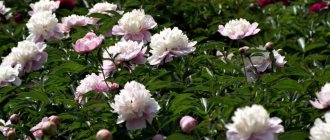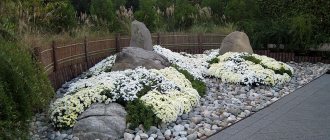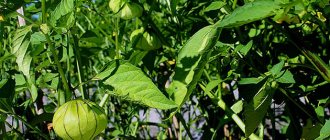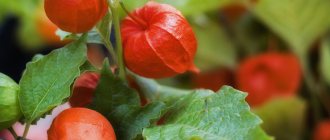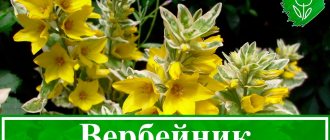Author: Elena N. https://floristics.info/ru/index.php?option=com_contact&view=contact&id=19 Category: Garden plants Published: January 27, 2019Last edits: January 13, 2021
- Planting tubers
- Anemone blanda
Anemone, like all proud beauties, requires special treatment. Therefore, no general recommendations, no universal advice! Almost each of the 160 (!) varieties of anemone has its own requirements for watering, soil, light... But don’t rush to give up whims! A certain formula for success in growing anemones (even if you don’t know the variety exactly!) still exists: plant in partial shade, organize drainage, as they grow, fertilize and loosen – half the battle is done!
- Why is the anemone afraid of weeding?
- How to organize continuous flowering of anemone on your site from April to November?
- How to wake up “lazy” flower seeds?
- How to organize proper wintering for a plant?
Read about all this in our article.
Planting and caring for anemones
- Planting: sowing fresh seeds for seedlings in June-July or before winter (October-November) in boxes. Planting tubers in spring.
- Flowering: spring, summer or autumn - depending on the species.
- Lighting: for forest species - partial shade, for Mediterranean species - bright sunlight.
- Soil: loose, fertile, (sandy or peat), preferably neutral.
- Watering: only in dry times and during the flowering period.
- Fertilizing: liquid organic and mineral fertilizers during the flowering period and in autumn.
- Reproduction: seed and vegetative (tubers, dividing the bush or parts of the rhizome).
- Pests: Leaf nematodes, aphids, South American leaf miners, thrips and whiteflies.
- Diseases: gray rot, peronosporosis (downy mildew), anthracnose, sclerotinia, viral infections.
Read more about growing anemones below.
The name of the plant anemone (lat. Anemone) , or anemone from Greek, is literally translated as “daughter of the winds,” since anemone flowers react by fluttering their petals even to the weakest gust of wind. The flower belongs to the buttercup family and is a perennial herbaceous plant. It is found in temperate climates on the plains and mountainous regions of both hemispheres. There are about 160 species, blooming at different times and in very different ways, which confuses even experienced gardeners. How to grow anemones will be discussed in this article.
Forcing flowers in winter
Anemone is one of those plants that can be forced out of the warm season. This is due to the fact that the anemone tuber/root remains active even in winter.
Typically, planting material is planted in small (no more than 15 cm in diameter) pots filled with peat and sand from September to December . With such planting, the anemone usually blooms within 60–70 days.
Important! When forcing, you must maintain a constant temperature regime of no higher than 12 °C.
Features of cultivation
Among the variety of species and varieties of anemones, there are some that are completely unpretentious, and there are those that require special care, and this difference is explained by the fact that some anemones have rhizomes, while others have tubers. Species with rhizomes are easy to grow, but mistakes in caring for tuberous anemones lead to serious consequences.
- Foliar feeding of plants by leaf: when and what to apply
There are a few things to consider if you are interested in growing anemones.
- Firstly, these flowers require mandatory watering in dry, hot weather.
- Secondly, autumn fertilizing should be carried out with complex mineral fertilizers, and the soil should be fertilized before planting or during growth and flowering - with organic fertilizers.
- Thirdly, in winter, protect the anemones from frost by covering them with dry leaves.
- And lastly: it is best to propagate anemones in the spring by root suckers or seeds sown closer to winter. We will dwell on all these features in more detail below.
Anemone - contraindications for use
In addition to the fact that anemone has many positive effects on humans, it also has many very important contraindications:
- Herbs and medicines from anemone are strictly prohibited for pregnant women.
- Anemone has a very strong abortifacient effect. The grass can cause abortion at any stage of pregnancy (or fetal death).
- Anemone is prohibited for women during lactation , as the plant can cause severe poisoning in a child. Do not forget that the plant is considered poisonous !
- People with any diseases or kidney disorders should use medicines prepared from anemone with caution , since it is this organ that removes the toxic substances of anemone from the body.
- In any treatment, it is necessary to strictly follow the dosage of anemone medications. If a person experiences the slightest signs of poisoning, action should be taken and seek help from a doctor.
- Anemone should not be given to small children under three years of age. It is necessary to give medicines from anemone to older children with caution and in small portions.
The main contraindication of anemone is its toxicity!
Preparing to plant anemones
Soil preparation
Before planting anemones, you need to choose a planting site and prepare the soil. The area will need to be spacious, shaded and protected from drafts. The rhizomes of anemones grow greatly during the season, but are so fragile that they are damaged by contact, and this must be taken into account. In addition, anemones do not tolerate extreme heat and drafts.
The soil is well-drained, loose and fertile. Loam or deciduous soil with peat is best. To create an ideal structure, add simple sand to the soil, and you can reduce excessive acidity, which is harmful to anemones, by adding dolomite flour or wood ash to the soil.
Seed preparation
Those who decide to grow flowers from seeds should know that anemone seeds have low germination rate: no more than a quarter germinates, and only from freshly collected seeds. But if you subject the seeds to stratification, that is, expose them to cold for 1-2 months, you can increase their germination. To do this, the seeds are mixed with coarse sand or peat at the rate of 1 part seeds to three parts sand, well moistened and sprayed with water daily to maintain the required humidity.
When and how to sow asters - advice from experienced gardeners
As soon as the seeds swell, add a little substrate, mix, moisten and place in a ventilated room with a temperature no higher than 5 ºC. A few days later, when the sprouts hatch, the container with the seeds should be taken out into the yard, buried in the snow or soil and sprinkled with sawdust or straw. In early spring, the seeds are transplanted into boxes for germination.
- Watermelon: growing from seeds in the garden, varieties
But to save yourself from all this hassle, it is better to plant the seeds in autumn in boxes with loose soil and bury them in the yard, covering them with cut branches. Over the winter they will undergo natural freezing, and in the spring you will dig them up and plant them.
In the photo: planting anemone seeds for seedlings in trays
Tuber preparation
Before planting, anemone tubers are awakened from sleep by soaking in warm water for several hours to swell, and then planted to a depth of 5 cm in pots with a damp mixture of peat and sand for germination. The soil in pots should be moistened moderately but regularly.
Some gardeners recommend “soaking” the anemone bulbs by wrapping them in a cloth well moistened with an epin solution and keeping them in a plastic bag for about six hours. After this, anemones can be immediately planted in the ground.
In the photo: Preparing anemone tubers for planting
Reproduction
Seeds
Seed propagation is difficult due to poor seed germination. In the best case, 25 percent of seedlings are obtained, and they still need to be grown before planting in a permanent place. Only ephemeroids reproduce by self-sowing, and not all of them. Wood anemone reproduces best by self-seeding.
Anemone seeds
Only freshly collected seeds are suitable for seed propagation. The easiest way is to sow seeds late in the fall in boxes filled with loose soil, cover with moss and bury the boxes in the ground in the yard. For the winter, cover with spruce branches or leaves of fruit trees. Under such conditions, the seeds will undergo natural stratification and seedlings will appear the following spring.
Planted seedlings of rhizomatous varieties must have at least two strong leaves. For tuberous varieties, wait until the leaves of the seedlings dry out, dig up the nodules and store them in a well-ventilated area until autumn.
Vegetative propagation
It is carried out in the spring, when the first shoots appear on the soil surface. We carefully dig up the plant, cut off a piece of rhizome with renewal buds and plant it horizontally in a permanent place and water it. Vegetative propagation can be done simultaneously with transplantation.
For an anemone that forms root shoots, at the beginning of the growing season we carefully dig out a piece of rhizome with a renewal bud, cut it off with a sharp knife or pruning shears and replant it in a permanent place.
By dividing the bush, varieties with vertical rhizomes are propagated. For each division there should be 2-3 renewal points.
It should be borne in mind that the anemone really does not like transplants, so it is better not to disturb it unless absolutely necessary. The easiest varieties to propagate are those that bloom in autumn.
Planting anemones
Planting tubers
Planting an anemone does not involve any special difficulties; the main thing is to determine the growth point. Pre-processed, swollen tubers have visible bud tubercles, and it is clear how to plant them. But if in doubt, remember: the top of the anemone tuber is flat, so you need to plant it with the sharp end down. If you are confused by the shape of the tuber, plant it on its side. The hole for the anemone should be 30-40 cm in diameter and 15 cm deep. Pour a handful of humus and ash into the bottom of the hole, then place the tuber, sprinkle it with soil and lightly press it down. Water the place where the anemone flowers are planted well.
In the photo: Anemone seedlings ready for transplanting into the ground
Planting seeds
By the time of planting, anemone seedlings must have at least two leaves. Seedlings are planted in the ground in a slightly shaded place in the second year of growth. If planting is carried out in the fall, the sown area is covered with branches or leaves from frost. Anemones grown from seeds will bloom only after three years.
Expert advice on growing freesia in open ground
As for the timing of planting tubers or seeds, you can ensure that anemones will bloom on your site from April to November if you purchase different varieties and plant them at the optimal time for each of them.
Anemone - tincture: application
are used to prepare medicinal remedies from anemone . Less commonly, the flowers themselves are used to prepare infusions and decoctions. You can also harvest the rhizome. A decoction of anemone root helps treat inflammation of the joints and relieve rheumatism.
It is very easy to prepare an infusion of anemone:
- An infusion can be prepared from fresh or dried leaves. The dry part should be taken in the amount of two grams, and the fresh part - 10 grams.
- Any leaves (dry or fresh) must be thoroughly chopped.
- The plant is poured with a glass of boiling water in a glass or ceramic container.
- After this, the dishes must be covered with a lid for steaming.
- In this state, the infusion should stand for at least four hours.
- The resulting infusion must be filtered from the plant part.
- It is necessary to take the resulting infusion one or two tablespoons and always before meals.
Preparation of an infusion for external use from anemone:
- Two small spoons of dry or fresh anemone herb (chopped) should be poured with a glass of purified or boiled water. The water should be cold.
- In this state, the plant should infuse for about a day in a cool and dark place.
- After infusion, the liquid is filtered from the plant part.
- The resulting infusion can be lubricated for the treatment and healing of wounds, ulcers, and eczema.
Important: It is noteworthy that such a cold infusion can be taken by men who experience sexual dysfunction. It is used internally, approximately 30 grams three times a day.
Preparation of anemone infusion
Anemone care
Caring for anemone is simple and not burdensome. The main problem in this matter is maintaining the required level of humidity throughout the entire growing season. The danger is that if overwatered, the root system may die from rot. And the lack of moisture, especially during the formation of buds, does not contribute to the growth and flowering of anemone. To balance the humidity level, plants should be planted at a higher elevation in an area with good drainage.
- Hyacinth after flowering
After planting, it is very advisable to mulch the area with a five-centimeter layer of foliage from fruit trees or peat. As for watering, in the spring it is enough to moisten the soil once a week; in moderate summers, the anemone does not need additional watering, the only exception being the crown anemone during the flowering period. During hot, dry summers, water daily in the morning or after sunset.
It is advisable to feed anemones during flowering with liquid organic matter (anemones do not like only fresh manure) and complex mineral fertilizers in the autumn. If you fertilized the bed before planting the anemone, then fertilizing can be omitted altogether. It is also recommended to regularly loosen the soil and pull out weeds. Or rather, do not weed, but dig through it with your hands, since you can damage the fragile root system of the anemone with a hoe.
Anemones are disease resistant; Sometimes they are harmed by slugs and snails, but a solution of metaldehyde will help you deal with these pests, which must first be collected by hand. Some anemones suffer from winter cutworm (cutworm caterpillar) or leaf nematode. When affected by a nematode, it is better to destroy the diseased plants and replace the soil in which they grew.
How to grow beautiful ranunculus at home and in the garden
Description of the plant
Anemones can be divided into two main groups:
- with rhizomes;
- with tubers.
Photo of delicate anemone flowers
Based on the structure of the root system, you need to start in organizing the care of the plant. Rhizomatous anemones are not as picky as those endowed with tubers.
Each individual species has its own care requirements, but there are general recommendations for anemones. So, plants need good drainage, a semi-shaded area in the garden and fertile soil. If there are no problems with the shady area, then you will need to tinker with creating a drainage layer.
Useful articles:
Soil salinization How to improve the soil, its fertility, composition, structure
Under the fertile layer of soil it is necessary to lay a layer of gravel, crushed stone or broken brick. To improve the heavy structure of the soil, it is recommended to introduce sand into it. Excessive soil acidity can harm anemones. The situation can be improved by adding dolomite flour or ash to the soil.
Anemone after flowering
In the climate of the middle zone, with the onset of autumn, anemones need to be removed from the soil and prepared for winter storage: dry the tubers, cut off the tops (the above-ground part of the bush) and store them in the dark and cool, placing them in peat or sand. A damp basement is best suited for this.
In the photo: Growing anemones in a flower bed
If you decide not to dig up anemones in anticipation of a warm winter, cover the area with fallen leaves or spruce branches so that unexpected frost does not destroy the flowers.
Anemone for cancer, how to take it?
Anemone is actively used in alternative medicine for the treatment of oncology. The plant extract is notable for the fact that in the early stages of the disease it is able to eliminate the slightest formations, and at other stages it can effectively fight tumor growth.
It is noteworthy that anemone “inhibits” the development of both benign and malignant tumors. To do this, you should take twenty drops of anemone decoction or infusion in boiling water three times a day before meals.
When treating with anemone, you should definitely pay attention to your well-being , because individual intolerance to the component can negatively affect your health and provoke poisoning. Before taking medications with plant extract, you should always consult with your doctor.
Use of anemone extract and medicines prepared from the plant for the treatment of cancer
Anemone species
Since the anemone flower is presented in great variety in culture and nature, and different types require different care, let's get acquainted with at least the most common representatives of the anemone family.
Types and features of caring for anemones. Based on the time of flowering, anemones are divided into spring and summer (or autumn). Spring anemones are very elegant, in a wide range of pastel shades: snow-white, cream, pink, blue, lilac... There are even double varieties. Spring anemones are ephemeroids, that is, their above-ground flowering cycle is short: waking up in April, they bloom in May, and in July they already retire, although in many species the leaves remain until autumn. Anemones differ in the type of rhizome. In the buttercup and oak anemones the rhizome is jointed and fragile, while in the tender anemone it is tuberous and slowly growing.
Anemone blanda
This plant is miniature, 5-10 cm in height, the most popular varieties are Blue Shades (blue), Charmer (pink), White Splendour (white).
In the photo: Tender Anemone (Anemone blanda)
Oak anemone (Anemone nemorosa)
Not so popular in our latitudes, the height of the bush is 20-30 cm, the diameter of the flower is 2-4 cm, the flowers are usually simple white, but in cultivation there are varieties with blue, lilac and pink flowers. There are even terry specimens. The main advantage is unpretentiousness.
In the photo: Anemone nemorosa
Anemone ranunculoides
It is also unpretentious, also has double varieties, the height of the bush is 20-25 cm, the flowers are bright yellow, slightly smaller than those of the oak anemone, and grows in almost any soil.
In the photo: Anemone ranunculoides
Summer-blooming (autumn) anemones are represented by such species as Japanese anemone (Anemone japonica), hybrid anemone (Anemone hybrida) and crown anemone (Anemone coronaria). As a rule, these are large perennials, whose powerful root system is well branched. They bloom from late summer to mid-autumn.
In the photo: Japanese Anemone (Anemone japonica)
Crown anemone (Anemone coronaria)
It blooms twice - in early summer and autumn. The peduncles of autumn species are strong and slender, from 80 cm to one and a half meters high, bearing up to several dozen simple or semi-double flowers of different shades. The most popular varieties of crown anemone are De Caen anemone, which has simple single flowers of a variety of colors, Mister Focker - blue flowers; terry anemone varieties Don Juan (bright red), Lord Jim (blue flowers).
In the photo: Crown Anemone (Anemone coronaria)
Hybrid anemone (Anemone x hybrida)
Known for such varieties as Honorine Jobert with white flowers, slightly pinkish below, semi-double dark purple anemone Profusion, Queen Charlotte, also a semi-double anemone of juicy pink color. Japanese anemone is most often represented in cultivation by such species as Pamina, with large dark pink, almost burgundy double flowers, Hadspen Abundance - a tall anemone with cream flowers, and Prinz Heinrich with semi-double bright pink flowers.
In the photo: Hybrid anemone (Anemone hybrida)
Forest (Anemone sylvestris)
This anemone is perennial because it thrives in temperate climates and tolerates winter cold well. She prefers light soils. It grows quickly, forming fluffy cushions of green leaves. The height of the plant varies from 25 to 50 cm. Its slightly drooping flowers are small (from 3 to 5 cm), painted white. They decorate the area at the end of May or at the beginning of June, and the flowering period lasts 2–3 weeks.
Wood anemone blooms longer in the shade than in an open area.
Plant varieties with larger (about 8 cm in diameter) and double flowers have been artificially bred.

